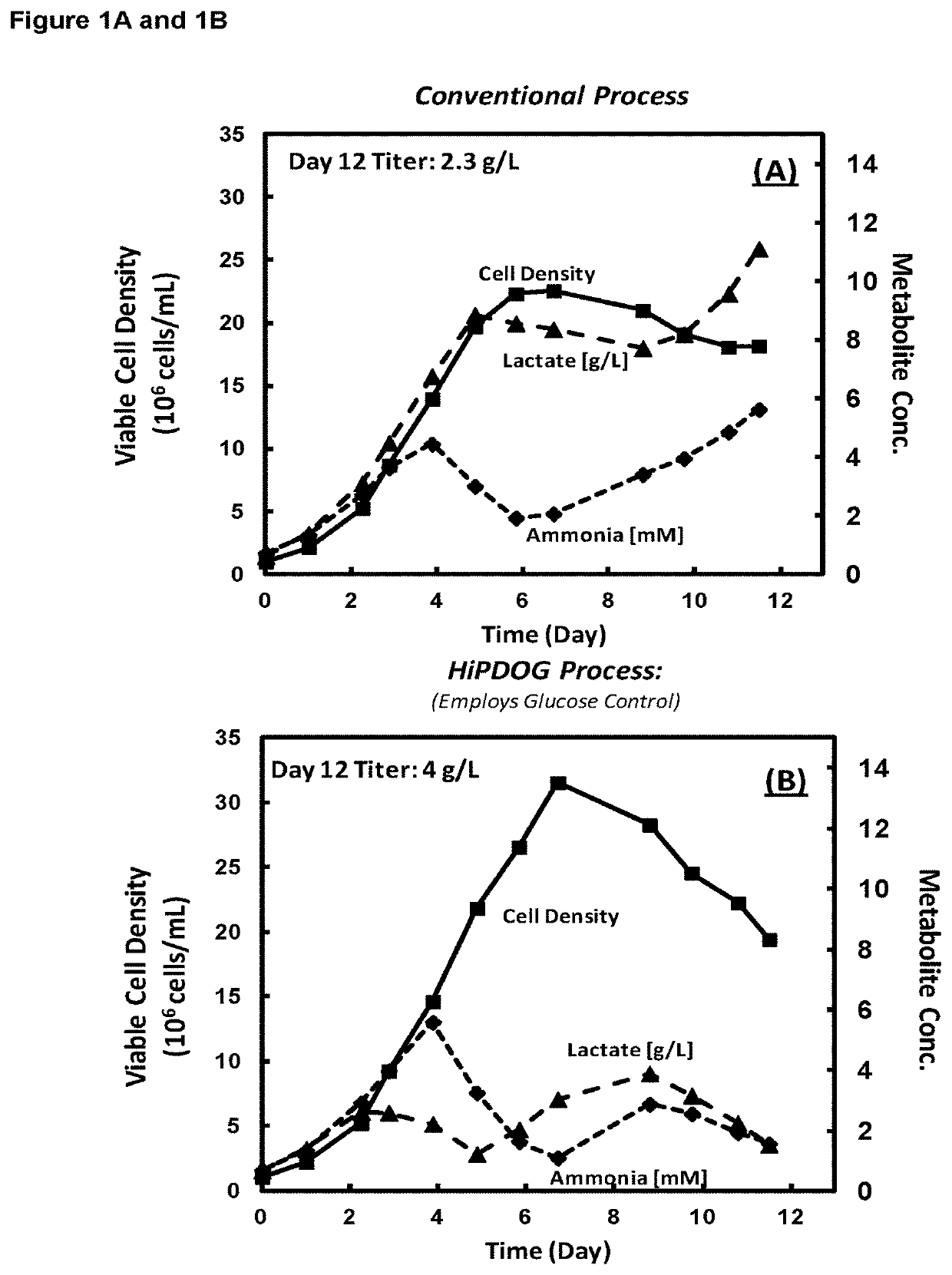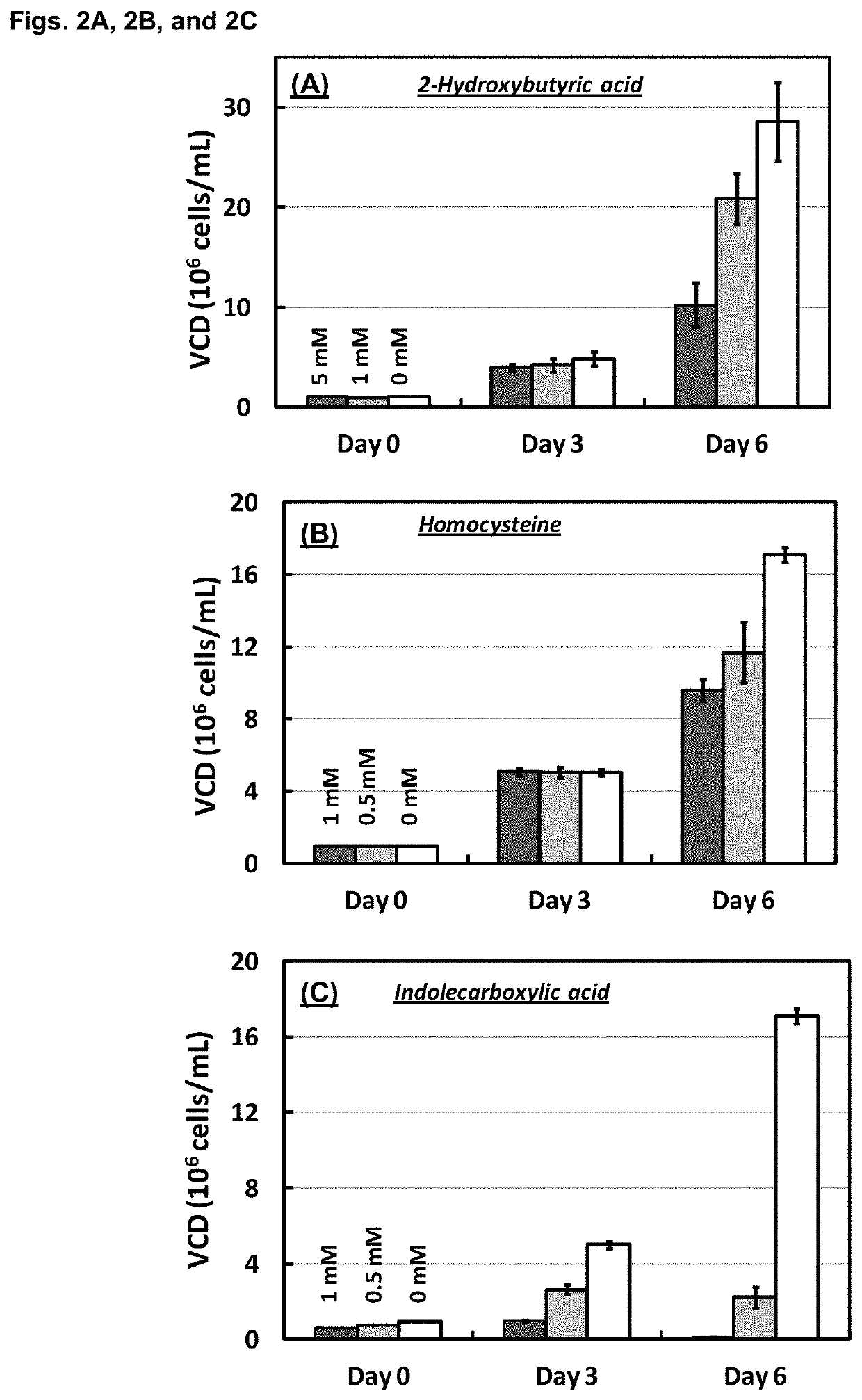Method of cell culture
a cell culture and cell technology, applied in the field of cell culture, can solve the problems of slowing down, inefficient cell metabolism, large amount of nutrient consumption and conversion,
- Summary
- Abstract
- Description
- Claims
- Application Information
AI Technical Summary
Benefits of technology
Problems solved by technology
Method used
Image
Examples
example 1
ation of the Metabolic Byproducts, Accumulating in Fed-Batch Cultures, which have Inhibitory Effects on Growth of Mammalian Cells in Culture
[0257]Goal:
[0258]This experiment was carried out to identify the major growth inhibitors (metabolic byproducts) accumulating in the glucose restricted and conventional fed-batch cultures of mammalian cells, using global metabolite profiling approaches.
[0259]Materials and Methods:
[0260]Cells and Medium
[0261]CHO cells comprising a glutamine synthase expression system (commercially available from Lonza) (hereafter GS-CHO, Cell line A) and expressing a recombinant antibody were used in the current experiment. Two types of medium were used in this experiment. First medium is “Medium A” which is used for inoculation of the experiment on day 0 of the culture. Second medium is “Medium B” which is the enriched nutrient media used as a feed medium for conventional and HIPDOG fed-batch processes (described in the next section).
[0262]Medium A is a fortified...
example 2
tion of the Concentration to which the Putative Inhibitors Accumulate in Late Stages of HIPDOG Fed-Batch Cultures
[0280]Goal:
[0281]This experiment was carried out to assess the concentrations of newly identified putative growth inhibitors (metabolic byproducts) at different time points in the HIPDOG fed-batch cultures of GS-CHO cells.
[0282]Materials and Methods:
[0283]Experimental setup is same as the one defined in Example 1. Quantification was performed by LC / MS and GC / MS methods for metabolites in the first two groups of Table 1 and NMR technology was used for quantification of the metabolites in groups 4 and 5. For first two groups of the metabolites listed in the metabolite column of Table 1, purified compounds were obtained commercially and solutions of these compounds at known concentrations were prepared using the Medium A as the base solvent. Using a similar LC / MS and GC / MS global metabolite profiling approach as that used for inhibitor identification and relative quantificat...
example 3
t to Establish the Growth Suppressive Effect of Identified Putative Inhibitors at the Concentrations Detected on Day 7 of the HIPDOG Fed-Batch Culture
[0286]Goal:
[0287]This experiment was carried out to assess the effect of the newly identified putative inhibitors, at the concentrations determined on day 7 of the HIPDOG culture, on growth of GS-CHO cells in culture. The independent effect of the nine metabolites (phenyllactate, 3-(4-hydroxyphenyl)lactate, 4-hydroxyphenylpyruvate, indolelactate, indolecarboxylic acid, homocysteine, 2-hydroxybutyric acid, isovalerate and formate) on growth of cells was tested first. Subsequently, synergistic effect for four metabolites (phenyllactate, 3-(4-hydroxyphenyl) lactate, 4-hydroxyphenylpyruvate and indolelactate) on cell growth was tested.
[0288]Materials and Methods:
[0289]GS-CHO cells producing a recombinant antibody were inoculated at low viable cell densities (0.1E6 cells / mL) in various conditions in 5 ml volume, 6-well plate cultures. These...
PUM
 Login to View More
Login to View More Abstract
Description
Claims
Application Information
 Login to View More
Login to View More - R&D
- Intellectual Property
- Life Sciences
- Materials
- Tech Scout
- Unparalleled Data Quality
- Higher Quality Content
- 60% Fewer Hallucinations
Browse by: Latest US Patents, China's latest patents, Technical Efficacy Thesaurus, Application Domain, Technology Topic, Popular Technical Reports.
© 2025 PatSnap. All rights reserved.Legal|Privacy policy|Modern Slavery Act Transparency Statement|Sitemap|About US| Contact US: help@patsnap.com



